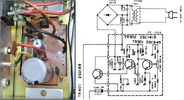I will admit I know nothing about power supplies. So a odd problem occurred on this radio. The power supply is working while plugged in to AC. I unplugged the AC cord and then Plugged in the 13.8V cord from my power supply and some wires burnt in the power supply of the radio. When this happened it did not blow the fuse in the radio but blew the fuse in the power cord going to my external power supply. The way I am looking at this the AC power supply is good and is still working. The problem is in the DC part. So far the bridge rectifier tests good. And that has nothing to do with DC power. There is a NEC 2SD188 and I am not sure exactly what that does but seems to have something to do with DC. I see someone was in there at least one time before me because a Cap has been changed and there are still remnants of the exploded Cap. I will post some pictures
Attachments
Last edited:





